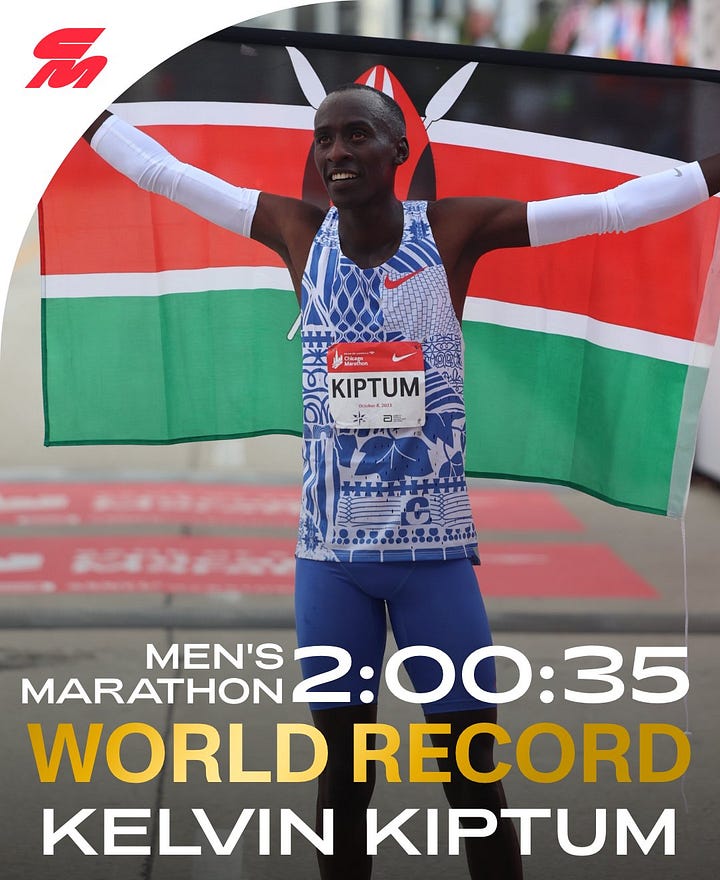
I spent the full week in San Diego at one of my favorite events. The festivities brought with them long hours, lots of hugs, and, unsurprisingly given that mix, a cold. As much as I wished it away, I couldn’t kick it — apparently hope is not a strategy to overcome illness. So, instead of running along trails, beach paths, and in gym hotels, I barely exercised at all. While much of the week was amazingggg, this part was far from ideal.
Since there’s not much to report on in training, this edition of the blog will share what I think about during times when I want to run and simply can’t. As always, I have fun odds n’ ends.
📋 Total miles: 9.5*
Monday: 4.5 miles (treadmill with Lever)
Tuesday: 4.0 miles
Wednesday: Off 🤒
Thursday: Off 🤒
Friday: Off 🤕
Saturday: Off 🤕
Sunday: Off 🤕
*Tuesday’s run was along the ocean in San Diego with one of my best friends and made my heart happy. And my emoji key is 🤒 for actively feeling awful and 🤕 for recovering while not feeling 💯.
👩🏼🎤 Streaking for runners
Spoiler alert: streaking in running circles is not about nakedness. Instead, it refers to people who run day-in and day-out with no break (often 1 mile or greater). It’s physically grueling, and increasingly popular. It’s also glamorous amongst the runfluncers. Some people have run every day for decades; others keep it up for months or a year.
A person I was close to was a streak runner. I have to admit that upon first hearing of his ambitions, I was intrigued. The discipline of it all appealed to me. I wasn’t in the position to start a streak at the time — I was in college and my running plan was dictated by the team — but I considered starting one of my own one day. That said, I vividly recall the moment the idea soured for me. Said person had a sports hernia that he trained through every day (wild…). On the day of his surgery to correct it, he ran before arriving at the hospital. The next day after discharge, he hobbled through 3 miles — his minimum run — on his home treadmill to keep the streak alive (even more wild…). Every day of his recovery included one of these runs of desperation. I found it irresponsible.
Weeks like the one I just had make me wonder what streakers do when they get sick. While working out consistently gives you an immune boost, I assume they’re not impervious to the occasional cold. For the people whose streaks are considerable, I imagine that some of the days they ran had to be brutal. I could have run every day this week, but it would have felt counterproductive — like literally going through the motions. I’m glad I know when to rest.
🤔 Rethinking my taper
Speaking of rest, I was supposed to be starting a monthlong process of tapering from hard training. Since hard training isn’t exactly what’s gone down, I am considering something different. When I say rethinking, I want to emphasize that this is a work in progress. As I’ve shared before, my training plan is broken into 4, 4-week segments. This last week was supposed to be the biggest week by volume of this cycle and the end of the 3rd segment, and I barely ran. This work was important, and I want to make it up without putting myself in a hole. That’s a tricky (potentially impossible??) balance to strike.
I’m holding off on establishing an updated plan for the final 4-week segment before the marathon until I feel back to running fully. I know myself, and if I put some high mileage week on the calendar this week I’ll want to complete it regardless of how prepared my body feels. I’m hoping returning home, as well as some extra naps in the early part of this week, will get me back on my feet.
🧳 Odds n’ ends
Inspired by: A new WR in the marathon and WR for Olympic/World Championship metals. I woke up early this morning and watched the live stream of the Chicago Marathon. I saw an hour of the coverage, which coincidentally was the last half of the men’s marathon because the winner, Kelvin Kiptum, ran an astounding 2:00.35. That time is truly hard to wrap my head around. Also, how amazing is Simone Biles? She became the most decorated athlete in history this week with her stellar comeback to elite global gymnastics at the World Championships. For this and many other reasons, she’s one of my heroes.


Delighted by: Interacting with you IRL. This weekend’s event was an opportunity to catch up with friends and acquaintances, and so many in both categories mentioned how much they’re enjoying the blog. A lot of you asked me about my recovery. A person asked me if I was able to lug the Lever on the plane (yes, but didn’t turn out to be that useful 🙃). A college senior who I knew could pick me out of a lineup (but perhaps not much beyond that) casually mentioned to me how impressed she was that I raced without headphones. My mind was blown. This may sound silly, but I truly didn’t realize this blog’s reach.
Thanks for all of your patience today; I know this is later than normal. The readers who I saw this weekend can vouch that I had very little time to write this until now. In fact, this post is being written at 35,000 ft on my way home. Next week I’ll come to you with resolved thoughts on my final prep — we’re getting so close to race day!





Dear Pen Pal,
I'm sorry to hear about your cold! I hope this finds you well on your way to running (and just generally being!) cold-free. It was cool to feel your enthusiasm about your San Diego visit and your emotional response to Tuesday's run. And it was cool to see your Tuesday run was out and about---I presume you didn't take treadmill and Lever oceanside?
Re: Streaking. Like you, I respect the discipline and commitment, but question whether do-or-die devotion to a streak is best for the athlete (or the holistic human). I guess it comes down to one's goals. If the primary goal is to streak, then the athlete serves the goal. If the primary goal is to be the best athlete one can be, then the training adjusts to the athlete---in good times and in bad, in sickness and in health. The authors of "Advanced marathoning" (who still don't pay me) respond to the streak mindset thus: "Plod through a few miles if you must, but be aware that you're prolonging your recovery."
Re: "I’m glad I know when to rest." And I'm glad you have clarity on and commitment to your goals, whatever you define them to be :) I think it was in "Peak performance" that I first encountered the mindset that rest and recovery is an integral part of training, not something one does when one is done (or not) training. Deena Kastor, in her autobiography, impressed me with her attention to deliberate rest and recovery.
Speaking of rest and recovery and rethinking your end-game running plan, let me advocate for an explicit post-race phase. I think being deliberate with this aspect of my training has helped me return smartly to running and exercise after racing a marathon. Also, it has given me something to look forward to, to use as a carrot-cum-stick in the race's final miles. "Body, I respect that you're tired, but you're looking at two weeks ahead with *max* three runs. So do right by our past training and give me what you got now!"
Re: Taper. Training plans that I've used, modified from those in "Advanced marathoning", prescribe a 3-week taper for an 18-week plan, and a 2-week taper for a 12-week plan. In the 12-week plans, the "-3" week (à la Python) has slightly lower volume than the preceding weeks in its phase, but its primary goal is still race preparation, not tapering. Thus, for example, the "-3" week features two hard workouts and a long run. I found the authors' discussion of tapering (Chapter 5 in the second edition) helpful to understand the tradeoffs involved and to make an informed plan.
Re: How amazing is Simone Biles? Whenever I think I'm close to an answer, she does something that redefines "amazing". I will give up trying to answer and just delight in Simone being Simone.
Re: Reach. I find it simultaneously empowering and humbling to see the unseen, unexpected impact our words and actions can have on others.
Carry on!